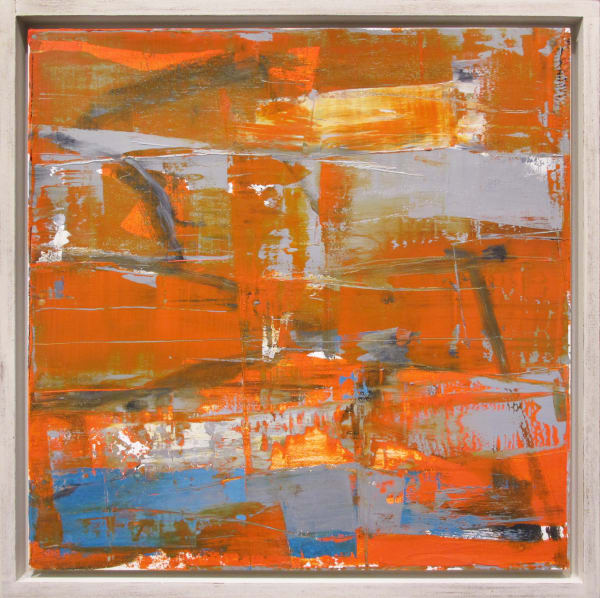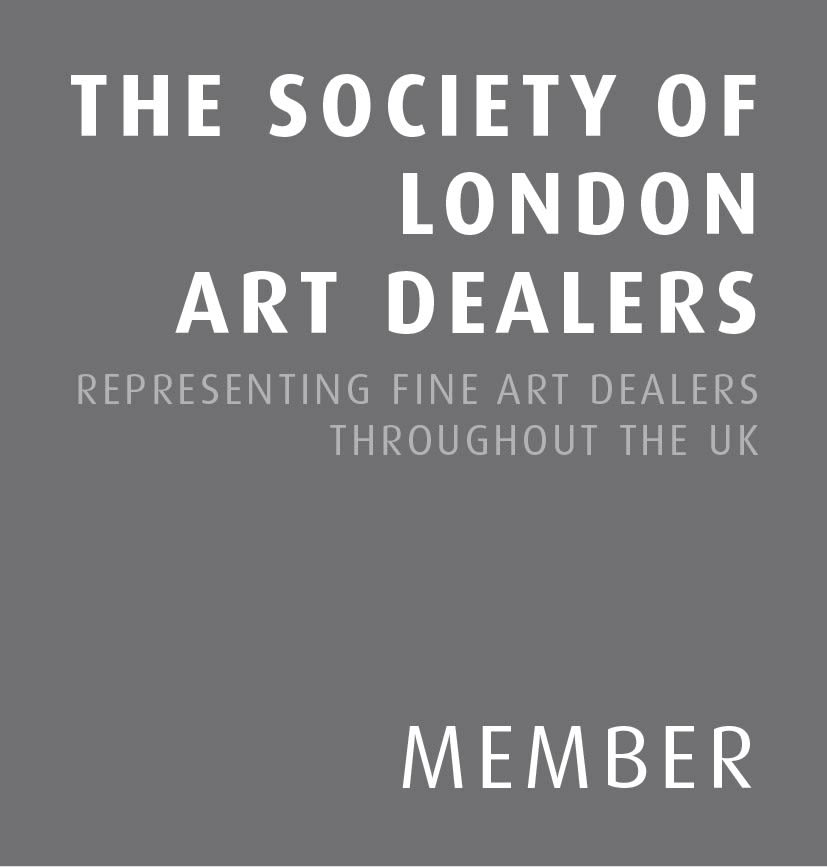-
 Jonathan S HooperStages - 3signed, titled and dated 2024 on basepainted aluminium on wood base23 x 11 cms (9 x 4 ins)£ 1,800.00
Jonathan S HooperStages - 3signed, titled and dated 2024 on basepainted aluminium on wood base23 x 11 cms (9 x 4 ins)£ 1,800.00 -
 Jonathan S HooperStages - 2signed and dated 2024 on basepainted aluminium20 x 7 cms (8 x 3 ins)£ 1,800.00
Jonathan S HooperStages - 2signed and dated 2024 on basepainted aluminium20 x 7 cms (8 x 3 ins)£ 1,800.00 -
 Jonathan S HooperHeadland No 4signed, titled and dated 2001 versooil, wax and resin on board122 x 61 cms (48 x 24 ins)£ 11,000.00
Jonathan S HooperHeadland No 4signed, titled and dated 2001 versooil, wax and resin on board122 x 61 cms (48 x 24 ins)£ 11,000.00
framed: 127 x 66 cms (50 x 26 ins) -
 Jonathan S HooperLight Echoes No 3signed, titled and dated 2020 versooil on panel41 x 41 cms (16 x 16 ins)£ 5,500.00
Jonathan S HooperLight Echoes No 3signed, titled and dated 2020 versooil on panel41 x 41 cms (16 x 16 ins)£ 5,500.00
framed: 44 x 44 cms (17 x 17 ins) -
 Jonathan S HooperHeadland No 12signed, titled and dated 2021 versooil, wax and resin on panel122 x 61 cms (48 x 24 ins)£ 11,000.00
Jonathan S HooperHeadland No 12signed, titled and dated 2021 versooil, wax and resin on panel122 x 61 cms (48 x 24 ins)£ 11,000.00
framed: 125 x 64 cms (49 x 25 ins) -
 Jonathan S HooperAtmosphere (7 layers)signed, titled and dated 2020 versooil on panel51 x 51 cms (20 x 20 ins)£ 5,800.00
Jonathan S HooperAtmosphere (7 layers)signed, titled and dated 2020 versooil on panel51 x 51 cms (20 x 20 ins)£ 5,800.00
framed: 53 x 53 cms (21 x 21 ins) -
 Jonathan S HooperLight Echoes No 5signed, titled and dated 2020 versooil on panel41 x 41 cms (16 x 16 ins)£ 5,500.00
Jonathan S HooperLight Echoes No 5signed, titled and dated 2020 versooil on panel41 x 41 cms (16 x 16 ins)£ 5,500.00
framed: 44 x 44 cms (17 x 17 ins) -
 Jonathan S HooperGrowansigned, titled and dated 2019/20 versooil on panel80 x 60 cms (31½ x 23½ ins)£ 8,500.00
Jonathan S HooperGrowansigned, titled and dated 2019/20 versooil on panel80 x 60 cms (31½ x 23½ ins)£ 8,500.00
framed: 83 x 63 cms (32½ x 24½ ins) -
 Jonathan S HooperErosion No 6signed, titled and dated 2017/2018 versooil on panel40 x 40 cms (16 x 16 ins)£ 5,500.00
Jonathan S HooperErosion No 6signed, titled and dated 2017/2018 versooil on panel40 x 40 cms (16 x 16 ins)£ 5,500.00
framed: 45 x 45 cms (18 x 18 ins) -
 Jonathan S HooperGrid. Grey. Orangesigned, titled and dated 2020 versooil on panel51 x 51 cms (20 x 20 ins)£ 5,800.00
Jonathan S HooperGrid. Grey. Orangesigned, titled and dated 2020 versooil on panel51 x 51 cms (20 x 20 ins)£ 5,800.00
framed: 56 x 56 cms (22 x 22 ins) -
 Jonathan S HooperRandom Walk No 1signed, titled and dated 2020 versooil on panel51 x 51 cms (20 x 20 ins)£ 5,800.00
Jonathan S HooperRandom Walk No 1signed, titled and dated 2020 versooil on panel51 x 51 cms (20 x 20 ins)£ 5,800.00
framed: 56 x 56 cms (22 x 22 ins) -
 Jonathan S HooperRandom Walk No 2signed, titled and dated 2020 versooil on panel51 x 51 cms (20 x 20 ins)£ 5,800.00
Jonathan S HooperRandom Walk No 2signed, titled and dated 2020 versooil on panel51 x 51 cms (20 x 20 ins)£ 5,800.00
framed: 56 x 56 cms (22 x 22 ins) -
 Jonathan S HooperLeskernick Fields No 4signed, titled and dated 2020 versooil on panel51 x 61 cms (20 x 24 ins)£ 6,200.00
Jonathan S HooperLeskernick Fields No 4signed, titled and dated 2020 versooil on panel51 x 61 cms (20 x 24 ins)£ 6,200.00
framed: 57 x 67 cms (22 x 26 ins) -
 Jonathan S HooperZennor 2signed, titled and dated 2024 versooil on panel40 x 40 cms (16 x 16 ins)
Jonathan S HooperZennor 2signed, titled and dated 2024 versooil on panel40 x 40 cms (16 x 16 ins)
framed: 44 x 44 cms (17 x 17 ins)Sold -
 Jonathan S HooperZennor 1signed, titled and dated 2024 versooil on panel40 x 40 cms (16 x 16 ins)
Jonathan S HooperZennor 1signed, titled and dated 2024 versooil on panel40 x 40 cms (16 x 16 ins)
framed: 44 x 44 cms (17 x 17 ins)Sold -
 Jonathan S HooperMolinia (Moor Grass)signed, titled and dated 2017 versooil on panel80 x 60 cms (31½ x 23½ ins)
Jonathan S HooperMolinia (Moor Grass)signed, titled and dated 2017 versooil on panel80 x 60 cms (31½ x 23½ ins)
framed: 83 x 63 cms (33 x 25 ins)Sold
Growing up in 1960s Cornwall, Jonathan S Hooper was surrounded not only by the elemental majesty of this resilient, rocky promontory but also by the creative tradition and legacy that this place provoked. The artist’s exposure to this tradition was far from casual. Through his father, Harry Hooper, a painter himself and a founding member of the Cornish Gliding Club, Peter Lanyon and Alan Davie were directly part of his landscape.
Steeped in this culture, Hooper eschewed the option of a more formal art training, instead choosing to follow a family tradition and study structural engineering at university. A master’s degree at Imperial College London followed, after which he returned to Japan – a country he first experienced as a hitchhiking student – living and working there for three years.
On leaving Japan, Hooper returned to painting and sculpture. An abiding interest in Japanese printing techniques and calligraphy is evident both in the way Hooper’s paintings are built up, and in how gestural, calligraphic marks often interrupt the painting plane.
His paintings seek to convey the experience of being ‘in’ landscape, as opposed to the less active state of looking or observing. Rooted in North Cornwall’s moors and coastal margins, this sense of place functions as a cipher through which to explore metaphysical concepts such as experience, memory, predisposition and imagination. Hooper uses the paintings to understand and reinforce his relationship with landscape; they are complexity maps.
Hooper views landscape as the matrix in which the whole of human experience is lived out. He is conscious, however, that we are losing our fundamental connection to landscape and wayfinding. His work explores the possibility that, through alternative ways of representing landscape, we can reinvigorate these links and rebuild the bridges to the uncultivated spaces.



















